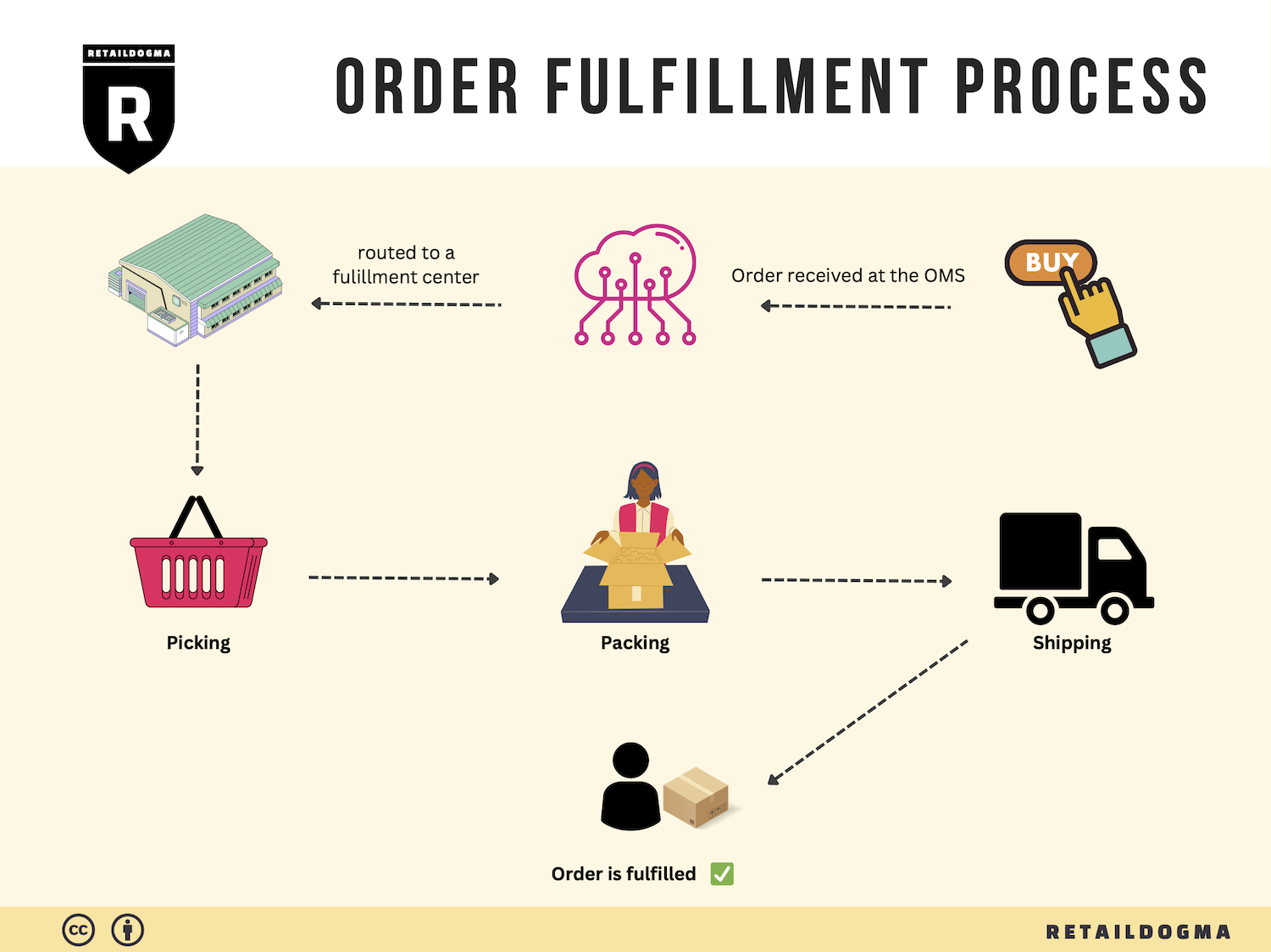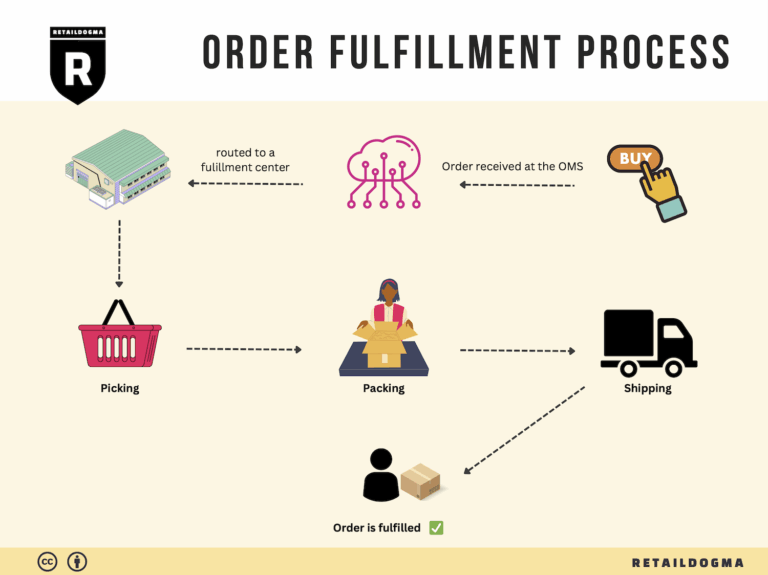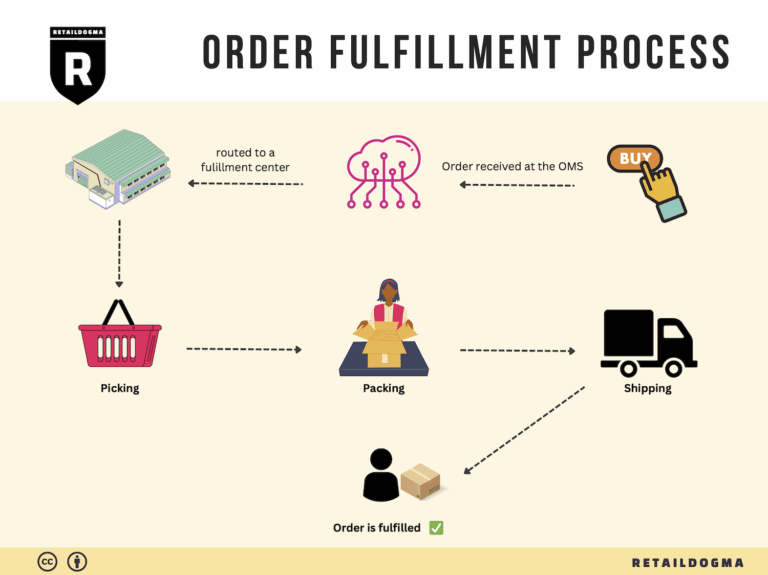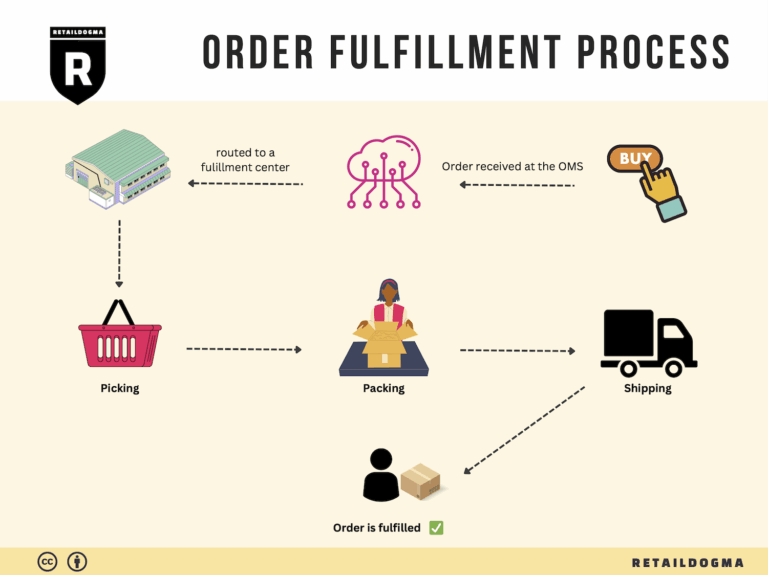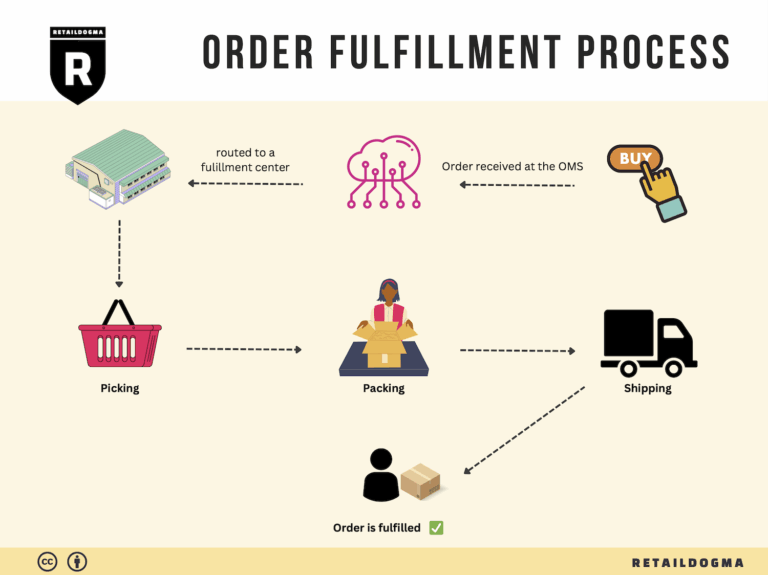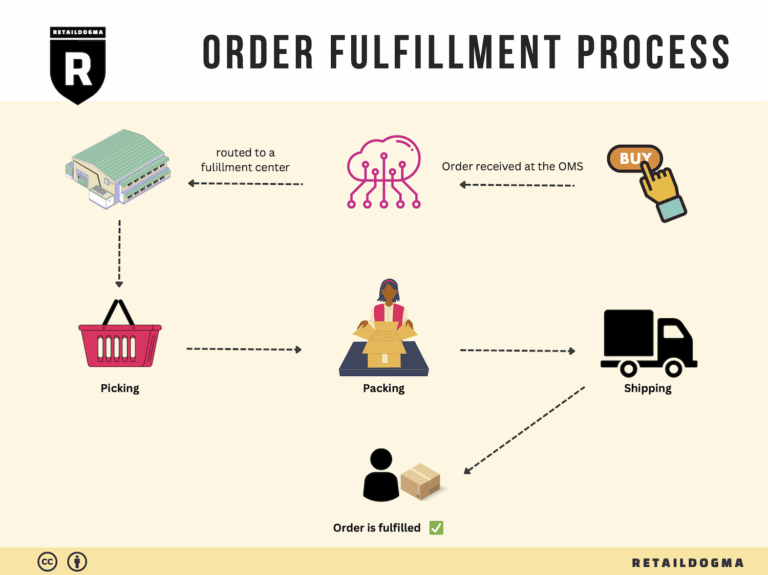Ecommerce Fulfillment Services: The Ultimate Guide (2025)
What is E-commerce Fulfillment? An Introduction for Growing Businesses
Understanding E-commerce Fulfillment: A Key to Scaling Your Business
As an e-commerce business owner, you may find yourself grappling with the complexities of packing and shipping orders. The excitement of growing sales can quickly turn into a logistical nightmare, leaving you overwhelmed by the sheer volume of orders and the intricacies of getting products to your customers. This is where e-commerce fulfillment comes into play.
E-commerce fulfillment refers to the entire process of receiving, processing, and delivering orders to customers. It encompasses everything from inventory management and order picking to packing and shipping. For growing businesses, mastering this process is crucial for maintaining customer satisfaction and ensuring operational efficiency.
In this guide, we’ll explore various fulfillment models to help you navigate the complexities of logistics. You will learn about options such as Third-Party Logistics (3PL) providers and Fulfillment by Amazon (FBA). Each model has its own advantages and challenges, and understanding these will empower you to choose the right path for your business.
We will also delve into the core services offered by fulfillment partners, which typically include inventory storage, order processing, packaging, shipping, and returns management. Knowing what services you require is essential for determining the best fit for your operational needs.
Choosing the right fulfillment partner is another critical aspect of scaling your e-commerce business. We’ll discuss key factors to consider, such as location, technology integration, scalability, and customer support. A reliable partner can significantly enhance your efficiency and help you meet customer expectations.
Lastly, we’ll break down the pricing structures associated with fulfillment services. Understanding the costs involved—whether it’s per-order fees, storage fees, or shipping costs—will allow you to budget effectively and avoid any unexpected expenses.
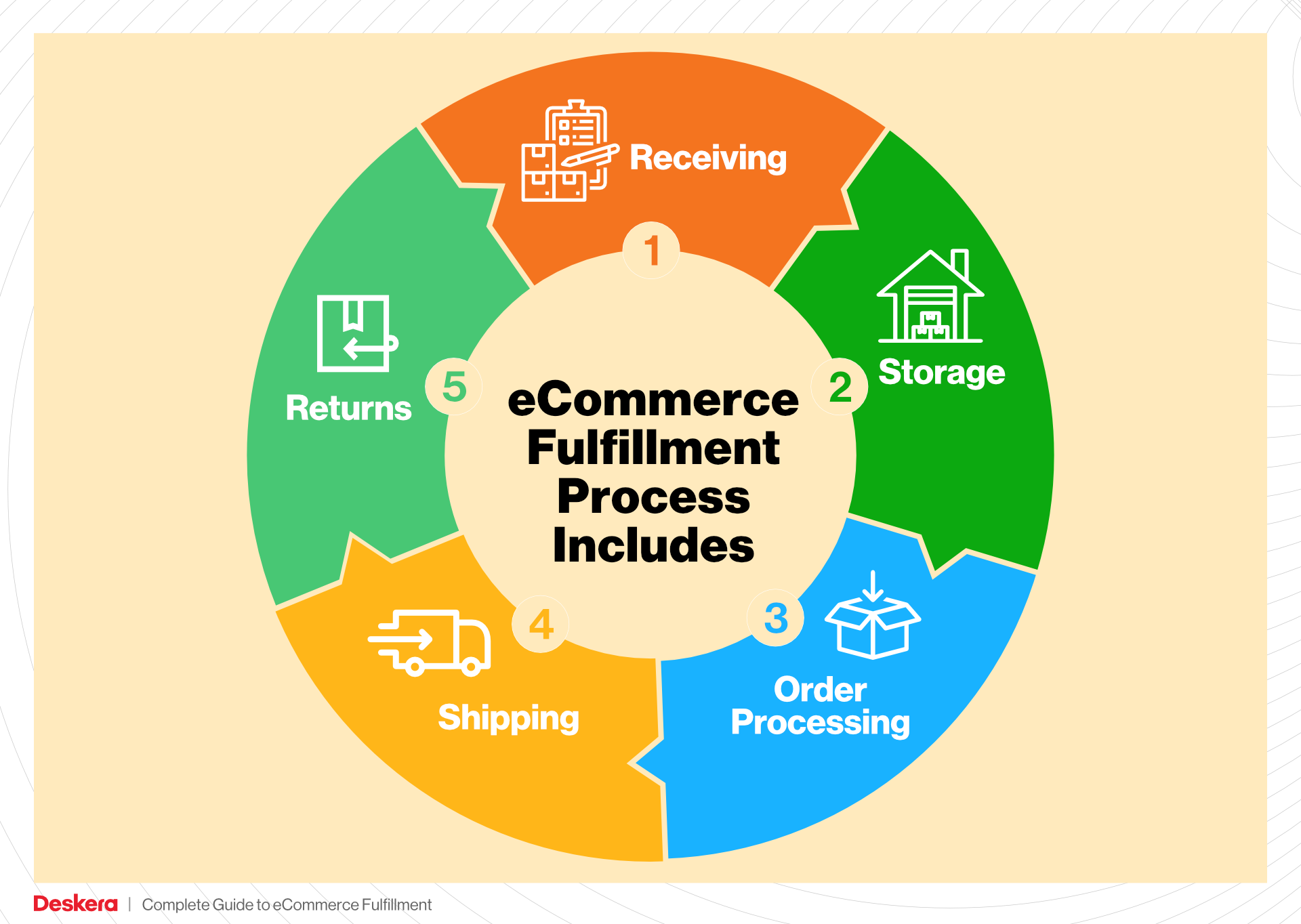
The goal of this guide is to empower you with the knowledge and tools necessary to make informed decisions about your logistics. With the right fulfillment strategy in place, you can focus on what you do best: growing your business and delighting your customers. Let’s dive in and simplify the fulfillment process for your e-commerce venture.
What You’ll Learn In This Guide
- What is E-commerce Fulfillment? An Introduction for Growing Businesses
- The Order Fulfillment Process: From ‘Buy’ Button to Customer’s Door
- Comparing Fulfillment Models: In-House vs. 3PL vs. Dropshipping
- A Deep Dive into Amazon FBA: Pros, Cons, and Who It’s For
- Core Services Offered by Fulfillment Centers
- How to Choose a Fulfillment Partner: A 6-Point Checklist
- Understanding Fulfillment Pricing: A Breakdown of Common Fees
- Frequently Asked Questions (FAQs) about Fulfillment
- Conclusion: Is Outsourcing Fulfillment the Right Move for Your Business?
- Important Disclaimer
The Order Fulfillment Process: From ‘Buy’ Button to Customer’s Door
1. Receiving Inventory
The order fulfillment process begins with receiving inventory, where products arrive at the fulfillment center from suppliers or manufacturers. This step is critical as it establishes the foundation for inventory management. During this phase, employees inspect shipments for accuracy, ensuring that the correct quantities and types of products are received. A key term associated with this step is SKU (Stock Keeping Unit), which is a unique identifier for each product that helps in tracking inventory levels.
Proper receiving procedures are essential to minimize discrepancies and ensure that inventory records reflect the actual stock on hand. Efficient receiving can lead to quicker turnaround times for fulfilling customer orders, ultimately enhancing customer satisfaction. Additionally, a well-organized receiving area helps streamline the process, making it easier for employees to check in inventory and prepare it for storage.
2. Warehouse Storage
Once the inventory has been received and verified, the next step is warehouse storage. This involves placing products in designated storage areas within the fulfillment center. The organization of the warehouse plays a significant role in the efficiency of the entire fulfillment process. Products are typically categorized based on various criteria such as size, type, or demand frequency.
A key term here is ABC analysis, which categorizes inventory into three classes (A, B, and C) based on their importance and sales volume. Class A items are high-value products with a low frequency of sales, while Class C items are lower-value items with a high sales frequency. By strategically placing high-demand items closer to the packing area, businesses can reduce picking times, ultimately speeding up order fulfillment.
3. Order Picking
The order picking phase is where the actual fulfillment of customer orders begins. Once an order is placed, the system generates a pick list, which is a document or digital display that indicates the items and quantities required to fulfill the order. Warehouse employees then navigate the storage area to retrieve these items.
This step is crucial because the accuracy and speed of picking directly affect customer satisfaction. Mistakes during picking can lead to incorrect orders, resulting in returns and dissatisfied customers. Implementing technology such as barcode scanning or pick-to-light systems can enhance picking efficiency and accuracy. Additionally, optimizing the picking route based on warehouse layout can further reduce the time spent locating items.
4. Order Packing
After items have been picked, they move to the order packing stage. Here, products are carefully packed into boxes or shipping containers for delivery. This step is vital for ensuring that items arrive at the customer’s door in perfect condition. Proper packing techniques, including the use of protective materials like bubble wrap or packing peanuts, help prevent damage during transit.
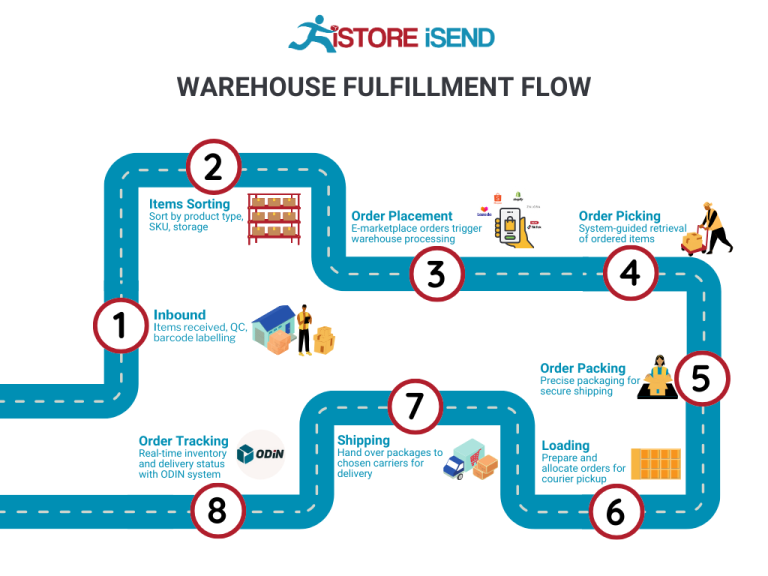
A significant term in this phase is packing slips, which are included in the package and outline the contents of the shipment. This not only serves as a receipt for the customer but also allows for easy verification of the order upon delivery. Efficient packing processes can minimize shipping costs and improve overall delivery times, enhancing the customer experience.
5. Shipping & Delivery
The final step in the order fulfillment process is shipping and delivery. Once packages are packed and labeled, they are handed over to shipping carriers for transportation to the customer’s location. This step is critical as it directly influences the delivery speed and the overall customer experience.
Key to this stage is the concept of last-mile delivery, which refers to the final leg of the shipping process from the distribution center to the customer’s doorstep. Fast and reliable last-mile delivery is increasingly becoming a competitive advantage for e-commerce businesses. Companies like Amazon are investing heavily in expanding their delivery networks to ensure quick turnaround times, which has been shown to increase customer loyalty and repeat purchases.
In conclusion, understanding and optimizing each step of the order fulfillment process—from receiving inventory to shipping and delivery—can significantly enhance operational efficiency, reduce costs, and improve customer satisfaction. By focusing on these key areas, e-commerce businesses can scale their operations effectively and remain competitive in a rapidly evolving marketplace.
Comparing Fulfillment Models: In-House vs. 3PL vs. Dropshipping
Fulfillment Model Comparison
| Model | Who Handles Inventory | Best For (Business Stage) | Key Advantage | Key Disadvantage |
|---|---|---|---|---|
| In-House Fulfillment | The business itself | Established businesses with stable demand | Complete control over operations and inventory | High overhead costs and resource allocation |
| Third-Party Logistics (3PL) | 3PL provider | Growing businesses looking to scale | Flexibility and reduced operational burden | Less control over inventory and fulfillment processes |
| Dropshipping | Supplier | Startups and small businesses | Low upfront investment and minimal risk | Lower profit margins and potential shipping delays |
In-House Fulfillment
In-house fulfillment involves managing all aspects of inventory, order processing, and shipping internally. This model is best suited for established businesses with stable demand and sufficient resources. Companies that choose in-house fulfillment enjoy complete control over their operations, allowing them to customize their processes to meet specific customer needs and enhance the overall customer experience. However, this model comes with significant overhead costs, including warehousing, staffing, and technology investments. Additionally, businesses must ensure they have the right infrastructure in place to handle fluctuations in order volume, which can lead to inefficiencies during peak seasons. For businesses that prioritize brand experience and have the capacity to invest in their logistics, in-house fulfillment can be a powerful strategy.
Third-Party Logistics (3PL)
Third-party logistics (3PL) providers manage logistics operations for businesses, including warehousing, inventory management, and shipping. This model is ideal for growing businesses looking to scale their operations without the burden of managing logistics themselves. By partnering with a 3PL provider, companies can leverage the provider’s expertise, technology, and infrastructure, resulting in increased efficiency and flexibility. This allows businesses to focus on core competencies such as product development and marketing while outsourcing the complexities of fulfillment. However, the trade-off is a loss of direct control over inventory and fulfillment processes, which can lead to discrepancies in service quality or delays. Businesses must carefully select a reputable 3PL partner to ensure alignment with their operational goals and customer service standards.
Dropshipping
Dropshipping is a fulfillment model where the retailer sells products without holding any inventory. Instead, when a customer places an order, the retailer forwards the order to a supplier who ships the product directly to the customer. This model is particularly attractive for startups and small businesses due to its low upfront investment and minimal financial risk. Retailers can offer a wide range of products without the burden of inventory costs, making it easier to test new markets and product lines. However, dropshipping often comes with lower profit margins, as retailers must share revenue with suppliers. Additionally, potential shipping delays and quality control issues can arise, as the retailer has limited oversight of the fulfillment process. Businesses considering dropshipping should prioritize building strong relationships with reliable suppliers to mitigate these risks and ensure customer satisfaction.
Conclusion
Choosing the right fulfillment model is crucial for e-commerce businesses aiming to scale effectively. Each model has its advantages and disadvantages, and the decision should be based on the business’s stage, resources, and long-term goals. In-house fulfillment offers control but comes with high costs, while 3PL provides flexibility and efficiency at the expense of direct oversight. Dropshipping appeals to new entrants looking to minimize risk but can present challenges in profitability and customer service. By understanding these models, e-commerce operators can make informed decisions that align with their strategic objectives and customer expectations.
A Deep Dive into Amazon FBA: Pros, Cons, and Who It’s For
Understanding Fulfillment by Amazon (FBA)
Fulfillment by Amazon (FBA) is a service provided by Amazon that allows e-commerce sellers to store their products in Amazon’s fulfillment centers. Amazon takes care of storage, packaging, and shipping, while also handling customer service and returns. This service is particularly appealing for businesses looking to scale their operations without the burden of managing logistics and fulfillment in-house.
When a customer places an order for a seller’s product, Amazon picks, packs, and ships the item directly to the customer. Sellers benefit from Amazon’s vast logistics network, which can often deliver products faster than they could manage on their own. Moreover, products fulfilled through FBA are eligible for Amazon Prime, which can significantly enhance visibility and attractiveness to potential buyers.
How FBA Works
-
Setup: Sellers sign up for an Amazon Seller account and choose the FBA option. They then create product listings and send their inventory to Amazon’s fulfillment centers.
-
Storage: Once the inventory is received at the fulfillment center, Amazon takes responsibility for storing the products. Sellers are charged a monthly storage fee based on the volume of space their products occupy.
-
Order Processing: When a customer orders a product, Amazon picks it from the shelf, packs it, and ships it directly to the customer. This process is optimized for speed and efficiency, leveraging Amazon’s advanced logistics technology.
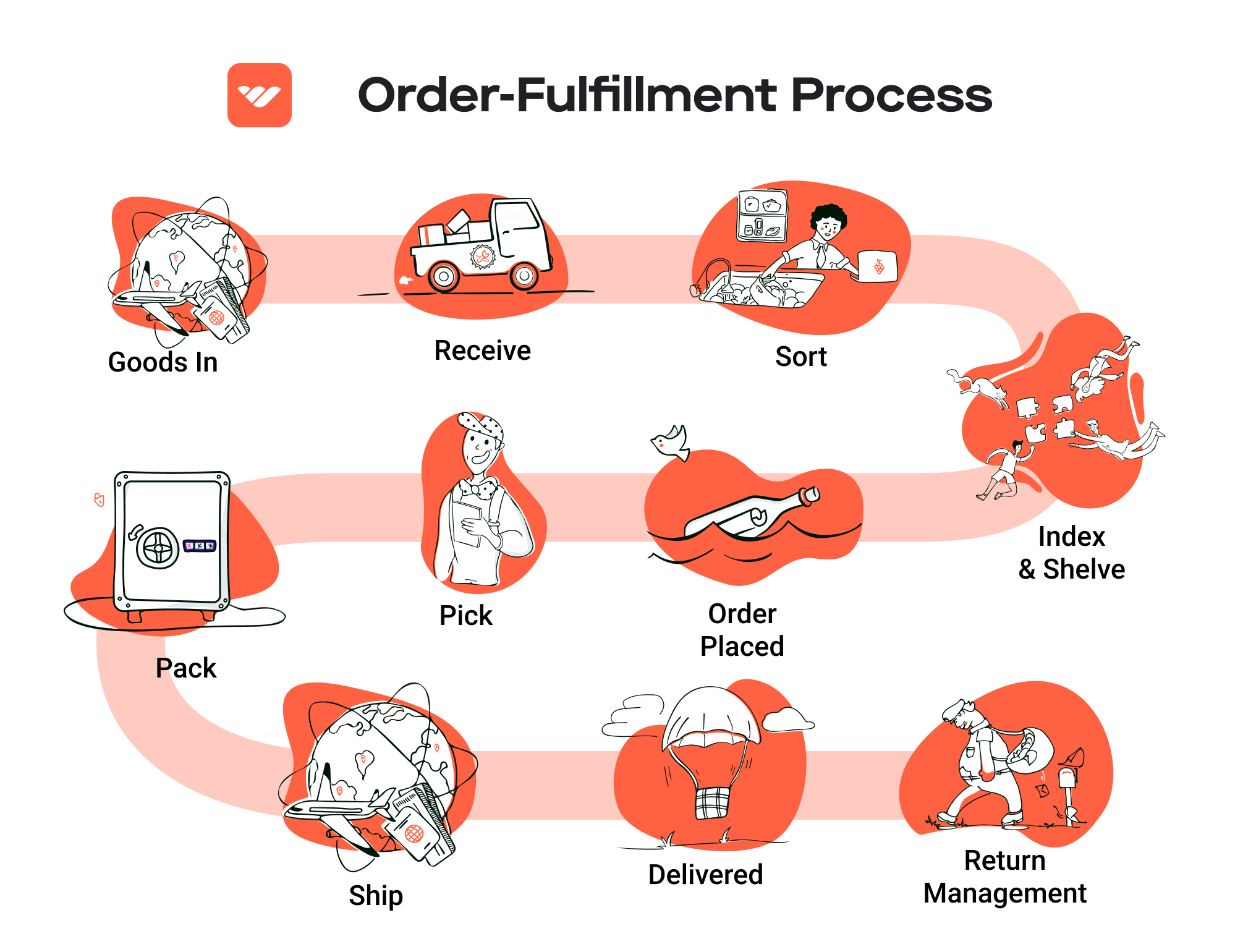
-
Customer Service: Amazon handles all customer service inquiries and returns for FBA products, providing a seamless experience for both sellers and buyers.
-
Payment: After the sale, Amazon deducts its fees from the seller’s account before transferring the remaining funds to the seller.
Pros of Using FBA
Prime Eligibility
One of the most significant advantages of FBA is that it makes your products eligible for Amazon Prime. Prime members are more likely to buy products that offer fast and free shipping. This can lead to increased sales and greater visibility in search results on Amazon.
Customer Trust
Products fulfilled by Amazon come with the assurance of Amazon’s reliable customer service and return policies. This builds trust with customers, as they know they can rely on Amazon for assistance if something goes wrong with their order.
Multi-Channel Fulfillment
FBA can also serve as a multi-channel fulfillment solution. Sellers can use FBA to fulfill orders from other sales channels, such as their own e-commerce website or other marketplaces. This centralizes inventory management and streamlines operations.
Scalability
FBA allows businesses to scale quickly without the need for significant investment in warehousing and logistics infrastructure. As demand increases, sellers can send more inventory to Amazon and leverage its established fulfillment network.
Time Savings
By outsourcing fulfillment to Amazon, sellers can focus on other critical aspects of their business, such as marketing, product development, and customer engagement. This can lead to better overall business performance.
Cons of Using FBA
High Fees
While FBA offers many conveniences, it also comes with various fees that can add up quickly. Sellers incur storage fees, fulfillment fees per item, and additional fees for long-term storage. These costs can significantly affect profit margins, especially for low-cost items.
Strict Inventory Rules
Amazon has stringent inventory management rules that sellers must follow. For example, products must be labeled correctly, and sellers must maintain certain inventory levels to avoid stockouts or excess storage fees. This can be challenging for sellers with fluctuating inventory needs.
Commingling Risks
FBA products may be commingled with those of other sellers, which can lead to complications, particularly if a customer receives a damaged or defective item. In such cases, Amazon may not be able to trace the origin of the product, complicating returns and refunds for sellers.
Loss of Control
By using FBA, sellers relinquish a degree of control over their fulfillment process. This includes aspects like packaging and shipping speeds. If there are delays or issues, sellers may not have direct oversight to resolve them quickly.
Limited Branding Opportunities
While FBA provides efficient logistics, it can limit branding opportunities. Products are shipped in Amazon-branded packaging, which may not allow sellers to create a unique unboxing experience for their customers.
Who is FBA Best For?
FBA is particularly well-suited for:
- Small to Medium-Sized Businesses: Businesses that lack the resources to manage their logistics can benefit significantly from FBA’s infrastructure.
- E-commerce Entrepreneurs: New sellers who want to enter the market quickly and efficiently can leverage FBA to handle fulfillment without upfront investments in warehousing.
- High-Volume Sellers: Businesses with large inventories and high sales volumes can take advantage of FBA’s economies of scale to reduce shipping costs and improve delivery times.
- Sellers Looking for Growth: For those aiming to expand their reach, FBA provides access to Amazon’s vast customer base, including Prime members.
In summary, Fulfillment by Amazon can be an invaluable tool for scaling e-commerce businesses. While it offers numerous advantages, sellers must weigh these against the potential downsides to determine if it aligns with their operational goals and profit margins.
Core Services Offered by Fulfillment Centers
Inventory Management & Warehousing
Inventory management and warehousing are the foundational services provided by fulfillment centers, crucial for e-commerce businesses aiming to optimize their supply chain operations. This service involves the systematic control of stock levels, storage locations, and the overall organization of products within the warehouse. Fulfillment centers utilize advanced inventory management systems that track inventory in real-time, allowing businesses to have a clear view of stock availability, turnover rates, and reorder points.
The benefits of effective inventory management and warehousing are substantial. Firstly, it reduces the risk of stockouts and overstock situations, which can lead to lost sales or increased holding costs. By employing techniques such as Just-In-Time (JIT) inventory, businesses can maintain leaner inventory levels, reducing storage costs while ensuring that popular products are always available for immediate shipment. Furthermore, automated inventory systems minimize human error, streamline order processing, and enhance the overall efficiency of operations, ultimately leading to improved customer satisfaction due to faster delivery times.
Pick and Pack Services
Pick and pack services are another critical offering from fulfillment centers that directly impact the efficiency of order fulfillment. This service involves the picking of individual items from inventory based on customer orders and packing them securely for shipment. Fulfillment centers employ trained staff and advanced technology, such as barcode scanning and automated picking systems, to ensure accuracy and speed in this process.
The advantages of utilizing pick and pack services are manifold. For one, it enables businesses to handle varying order sizes—from single items to bulk orders—without the need for extensive in-house labor. This flexibility allows e-commerce companies to scale operations efficiently as demand fluctuates. Additionally, fulfillment centers often offer customized packing options, including branded packaging and gift-wrapping, enhancing the customer experience and reinforcing brand identity. By outsourcing this function, businesses can also focus on their core competencies, such as marketing and product development, while leaving the logistics to experts.
Kitting and Assembly
Kitting and assembly services are specialized offerings that allow businesses to combine multiple products into a single package or kit before shipping. This service can include assembling products, creating promotional bundles, or preparing items for specific events or campaigns. Fulfillment centers equipped for kitting will have the necessary tools and labor to efficiently assemble these kits according to the specifications provided by the e-commerce business.
The key benefit of kitting and assembly services lies in the enhanced value they provide to customers. Bundled products often come at a discounted rate, encouraging larger purchases and increasing average order value. Moreover, this service can help streamline the fulfillment process, as kitted products can be shipped as a single item, reducing the complexity of order processing. For businesses running promotional campaigns, the ability to quickly assemble and ship kits can lead to a competitive advantage in the marketplace, ensuring that they meet customer demand swiftly and effectively.
Returns Management (Reverse Logistics)
Returns management, also known as reverse logistics, is a crucial service offered by fulfillment centers that deals with the processing of returned items. This service encompasses everything from receiving returns, inspecting and sorting items, restocking inventory, and managing the disposal of unsellable products. Effective returns management is essential in today’s e-commerce landscape, where customer expectations for hassle-free returns are high.
The benefits of a well-structured returns management process are significant. Firstly, it enhances customer satisfaction by providing a seamless return experience, which can lead to increased customer loyalty and repeat purchases. A fulfillment center can streamline the returns process, allowing businesses to quickly restock returned items and minimize losses associated with returns. Additionally, data gathered during the returns process can provide valuable insights into product quality and customer preferences, enabling businesses to make informed decisions about inventory, product offerings, and marketing strategies. In a competitive market, the ability to manage returns efficiently can differentiate a brand and foster customer trust.
Conclusion
In summary, fulfillment centers offer a range of core services that are essential for e-commerce businesses looking to scale efficiently. From inventory management and warehousing to pick and pack services, kitting and assembly, and returns management, these services not only streamline operations but also enhance customer satisfaction and drive sales. By leveraging the expertise and technology of fulfillment centers, e-commerce businesses can focus on growth while ensuring that their logistics operations are optimized for success.
How to Choose a Fulfillment Partner: A 6-Point Checklist
Location & Warehouse Network
Importance: The geographical location of your fulfillment partner’s warehouses is critical for ensuring timely delivery to your customers. A strategically placed fulfillment center can significantly reduce shipping times and costs, especially for businesses targeting specific regions.
Questions to Ask:
– Where are your warehouses located, and how do they align with our target customer base?
– What is your average shipping time to key areas we serve?
– Can you provide information on your logistics network and any partnerships with carriers?
Technology & Integrations
Importance: In today’s e-commerce landscape, technology plays a vital role in streamlining operations. Your fulfillment partner should have robust systems that integrate seamlessly with your e-commerce platform, inventory management, and order processing systems. This integration helps in real-time tracking and efficient management of your supply chain.
Questions to Ask:
– What technology platforms do you use for order management and inventory tracking?
– Can your systems integrate with our existing e-commerce solutions (e.g., Shopify, WooCommerce, Amazon)?
– Do you provide real-time tracking for orders and inventory levels?
Specializations (e.g., Cold Storage, Oversized Items)
Importance: Depending on your product offerings, you may require specialized services. For instance, if you sell perishable goods, a partner with cold storage capabilities is essential. Similarly, if you deal with oversized items, ensure the partner has the necessary infrastructure to handle such products.
Questions to Ask:
– What specializations does your fulfillment center offer?
– Can you accommodate unique product requirements, such as temperature control or oversized packaging?
– How do you handle specialized inventory, and what measures are in place for quality control?
Scalability & Capacity
Importance: As your business grows, so will your fulfillment needs. A good fulfillment partner should have the capacity to scale operations in response to your growth, whether through increased order volumes or expanded product lines. Understanding their ability to handle peak seasons and unexpected surges is also crucial.
Questions to Ask:
– What is your current capacity, and how do you manage fluctuations in order volume?
– Can you accommodate seasonal spikes in demand, and what systems do you have in place for this?
– What is your process for scaling operations if our business requires it?
Pricing and Contracts
Importance: Transparent pricing structures and flexible contract terms are essential when choosing a fulfillment partner. Understanding the cost associated with various services will help you budget effectively and prevent unexpected expenses.
Questions to Ask:
– Can you provide a detailed breakdown of your pricing model, including any hidden fees?
– What is included in the base pricing, and are there additional costs for services like returns or special packaging?
– What are the terms of your contracts, and do you offer flexibility for scaling or changes in service needs?
Customer Support & Reviews
Importance: Exceptional customer support can make or break your relationship with a fulfillment partner. You need assurance that they will be responsive and proactive in addressing any issues that arise. Additionally, reviewing their reputation can provide insights into their reliability and service quality.
Questions to Ask:
– What support services do you offer, and how can we reach you in case of issues?
– Can you provide testimonials or references from other clients in our industry?
– How do you handle disputes or problems, and what is your escalation process?
Conclusion
Choosing the right fulfillment partner is a pivotal decision that can significantly impact your e-commerce success. By carefully evaluating potential partners against this checklist, you can make an informed decision that aligns with your business needs and growth aspirations. Prioritize these factors based on your specific requirements, and don’t hesitate to ask for clarifications or additional information during your discussions with potential partners.
Understanding Fulfillment Pricing: A Breakdown of Common Fees
Initial Setup Fees
When you first engage with a fulfillment service, initial setup fees are often the first costs you’ll encounter. These fees typically cover the onboarding process, which may include account creation, system integration, and initial training for your team on how to use the fulfillment platform. Depending on the complexity of your inventory and the service provider’s infrastructure, these fees can range from a few hundred to several thousand dollars.
To calculate these fees, providers often consider the size of your inventory, the number of SKUs (stock keeping units), and the level of customization needed for your fulfillment operations. It’s essential to clarify what is included in these fees—whether they cover software integration, training sessions, or other operational necessities.
Receiving Fees
Receiving fees are charged when your products arrive at the fulfillment center. These fees cover the labor and resources involved in unloading, inspecting, and storing your goods. Typically, this fee is calculated based on the number of pallets or units received.
For example, if a fulfillment center charges a flat rate per pallet received, you would multiply that rate by the number of pallets you send. Some providers may also have tiered pricing based on volume; the more you send, the lower the rate per pallet. Be sure to ask about any additional charges that might apply for damaged goods or products requiring special handling during the receiving process.
Storage Fees (per pallet/bin)
Storage fees are incurred for keeping your inventory in the fulfillment center. These fees can be calculated on a monthly basis, either per pallet or per bin, depending on how your inventory is organized within the warehouse.
The rate can vary significantly based on the location of the fulfillment center, the time of year (with peak seasons often incurring higher rates), and the total amount of space your products occupy. For example, a fulfillment center may charge $10 per pallet per month. If you have 10 pallets, your storage fee would be $100 monthly. Additionally, consider that some providers may have long-term storage fees for items stored beyond a certain period, which can impact your cash flow.
Pick & Pack Fees (per item/order)
Pick and pack fees are one of the most variable components of fulfillment pricing. These fees cover the labor involved in selecting items from inventory and packing them for shipment. Generally, they are calculated on a per-item or per-order basis.
For instance, if a fulfillment center charges $1.50 per item picked and packed, and your order contains five items, you would incur a charge of $7.50 for that order. Some providers may also implement tiered pricing based on order volume; larger orders may attract a lower per-item fee. Understanding how these fees scale with your order volume is crucial for budgeting, especially as your business grows.
Shipping Fees
Shipping fees are typically the final component of your fulfillment costs and can vary widely based on several factors, including package weight, dimensions, shipping speed, and destination. Most fulfillment centers partner with major carriers, and the rates they offer can differ based on the shipping agreements in place.
Shipping fees are often calculated based on the dimensional weight of the package, which considers both the actual weight and the size of the package. For example, a lightweight item in a large box may incur higher shipping fees than a heavier item in a smaller box. Additionally, many fulfillment centers offer discounted shipping rates based on volume, which can result in significant savings for businesses with high shipping volumes.
Tips for Getting an Accurate Quote
To ensure you receive an accurate quote from a fulfillment service, consider the following tips:
-
Detail Your Inventory: Provide a comprehensive list of your products, including dimensions, weights, and any special handling requirements. This information will help the fulfillment center give you a precise estimate.
-
Ask for a Breakdown of Fees: Request a detailed breakdown of all potential fees, including initial setup, receiving, storage, pick and pack, and shipping. Understanding each component will help you budget effectively.
-
Inquire About Volume Discounts: If you expect your order volume to increase, ask about potential discounts for higher volumes. This could significantly reduce your overall fulfillment costs.
-
Review Terms for Long-Term Storage: Clarify any long-term storage fees or penalties, especially if your inventory turnover is slower than anticipated.
-
Evaluate Additional Services: Consider any additional services that may incur extra costs, such as kitting, labeling, or returns processing.
By following these guidelines, you can make a well-informed decision about which fulfillment provider aligns best with your business needs and budget.
Frequently Asked Questions (FAQs) about Fulfillment
1. What is the Amazon Fulfillment Center RNO4?
The Amazon Fulfillment Center RNO4 was a logistics facility located in Reno, Nevada, primarily dedicated to handling large and bulky shipments. Opened in 2015, it was part of Amazon’s broader strategy to enhance its distribution network in the region, but it is set to close in August 2025 as Amazon shifts its focus toward building faster, same-day delivery capabilities in Reno.
2. Why is the RNO4 fulfillment center closing?
The closure is part of Amazon’s strategic realignment of its delivery network to improve shipping speeds. The lease for the RNO4 facility is expiring, and the company has decided to not renew it, opting instead to invest in a new same-day delivery facility in the area.
3. How will the closure of RNO4 affect employees?
The closure will impact approximately 325 employees. Amazon is offering transfer opportunities to other facilities in the region and providing severance packages, transitional health benefits, and job placement support for those who choose not to relocate.
4. What’s the difference between a warehouse and a fulfillment center?
A warehouse is primarily focused on storing goods, while a fulfillment center is designed to process and ship orders directly to customers. Fulfillment centers often have advanced technology and systems in place to handle inventory management, order processing, and shipping logistics efficiently.
5. What is a Third-Party Logistics Provider (3PL)?
A Third-Party Logistics Provider (3PL) is a company that offers outsourced logistics services, including warehousing, inventory management, transportation, and fulfillment. Businesses often partner with 3PLs to streamline their supply chain operations and focus on their core competencies.
6. How much do fulfillment services cost?
The cost of fulfillment services can vary widely depending on factors such as the size and weight of products, order volume, storage needs, and the specific services offered. On average, businesses can expect to pay for storage fees (per pallet or cubic foot), pick-and-pack fees (per order), and shipping costs. It’s essential to get quotes from multiple providers to find a solution that fits your budget.
7. What types of products were handled at the RNO4 fulfillment center?
The RNO4 fulfillment center primarily handled big-and-bulky items, including larger consumer goods that require specialized handling and shipping methods. This included furniture, appliances, and other heavy items that are not typically suited for standard fulfillment processes.
8. How does Amazon’s fulfillment network impact delivery speeds?
Amazon’s fulfillment network is designed to optimize delivery speeds by strategically locating fulfillment centers close to major customer bases. This allows for faster order processing and shipping, including same-day and next-day delivery options, which are crucial for maintaining customer satisfaction and competitive advantage in e-commerce.
9. Can businesses still partner with Amazon for fulfillment after RNO4 closes?
Yes, businesses can still partner with Amazon for fulfillment services through other operational centers and fulfillment networks. Amazon has multiple fulfillment centers across the U.S. and continues to expand its logistics capabilities, including new same-day delivery facilities in various locations.
10. What should businesses consider when choosing a fulfillment partner?
When selecting a fulfillment partner, businesses should consider factors such as the provider’s location, service offerings, technology integration, pricing structure, scalability, and customer service. It’s essential to align the fulfillment capabilities with your business needs to ensure efficient order processing and customer satisfaction as you scale.
Conclusion: Is Outsourcing Fulfillment the Right Move for Your Business?
Evaluating the Benefits of Outsourcing Fulfillment
In today’s competitive e-commerce landscape, outsourcing fulfillment can be a game-changer for businesses aiming to scale efficiently. By partnering with a fulfillment service, you gain significant advantages, including time savings, scalability, and access to specialized expertise.
One of the most compelling benefits of outsourcing fulfillment is the time it frees up for you and your team. Handling logistics in-house can be a resource-intensive endeavor that distracts from core business activities, such as marketing and product development. With a fulfillment partner, you can delegate the complexities of inventory management, order processing, and shipping, allowing you to focus on driving sales and enhancing customer experiences.
Scalability is another critical factor. As your business grows, so do your logistical demands. Fulfillment partners often have the infrastructure and technology to handle spikes in order volume, seasonal fluctuations, and geographic expansion. This flexibility enables you to respond swiftly to market changes without the burden of additional capital investment in warehousing or staffing.
Moreover, leveraging the expertise of a fulfillment service provides you with insights into best practices and efficiencies that might be outside your current knowledge base. From optimizing shipping routes to implementing advanced inventory systems, these partners can help streamline operations and reduce costs.
However, the success of outsourcing fulfillment hinges on selecting the right partner. It’s essential to align your business needs with the capabilities of the fulfillment provider. Assess their track record, technology, and customer service to ensure they can support your growth trajectory effectively.
Take Action Today
To determine whether a fulfillment partner is the right move for your business, conduct an audit of your current shipping process. Analyze your operational pain points, shipping times, and costs. This evaluation will provide clarity on whether outsourcing fulfillment could enhance your efficiency and scalability, ultimately propelling your business forward.
Important Disclaimer
⚠️ Important Disclaimer
The information in this guide is for educational purposes. Fulfillment services, pricing, and platform features change frequently. Always conduct your own due diligence and consult with providers directly before making business decisions.
